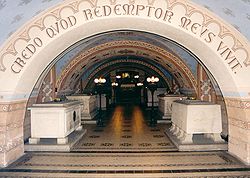Pauline Basilica (Krakow)
| Pauline Basilica | |
|---|---|
|
View from the east |
|
| Construction year: | before 1270 |
| Inauguration: | before 1270 |
| Style elements : | Baroque |
| Client: | Catholic Church |
| Location: | 50 ° 2 '54 " N , 19 ° 56' 16" E |
| Address: | ul.Skałeczna 15 Krakow Poland |
| Purpose: | Roman Catholic Pauline Church |
| Diocese : | Krakow |
The Paulinerbasilika (Polish: Bazylika Paulinów ) or Michael-und-Stanislausbasilika (Polish: Bazylika św. Michała Archanioła i św. Stanisława Biskupa ) in Krakow is a Catholic church at ul.Skałeczna 15 in the Kazimierz district south of Kraków's old town .
history
Kraków's Pauline Monastery on Skałka Hill is located in the old Polish capital on the site of the former Michaelis Church, where Bishop Stanisław Szczepanowski, later St. Stanisław , was allegedly killed by his supporters in 1079 as a result of a power struggle with King Bolesław II . Stanisław was canonized by the Pope in the 13th century, following the example of Thomas Becket , and as a result became a kind of national saint of Poland. First a small Romanesque church was built on site under the patronage of St. Archangel Michael . In the 14th century, King Casimir the Great had a Gothic church built, which in 1472 was taken over by the Pauline monks who had been brought to Krakow . Today's baroque church, which is consecrated to both Michael and Stanislaus, was built between 1733 and 1751 according to plans by Anton Müntzer and Antonio Solari . Inside the church, the altarpiece by Tadeusz Kuntze (around 1758) is important. In the far left nave there is the St. Stanislaus Altar with an image of a saint from the 18th century and various relics . In 2003 Pope John Paul II elevated the church to the rank of minor basilica .
Between 1876 and 1880 a kind of “ National Pantheon of Deserved Poles ” was built in the vaults of the church . On the occasion of the 400th anniversary of the death of the chronicler and writer Jan Długosz , who is also buried there, a crypt was laid out in which a number of prominent Poles have been buried to this day. These include the writers Adam Asnyk , Józef Ignacy Kraszewski , Stanisław Wyspiański and most recently (2004) Czesław Miłosz , the painters Henryk Siemiradzki and Jacek Malczewski and the composer Karol Szymanowski .


